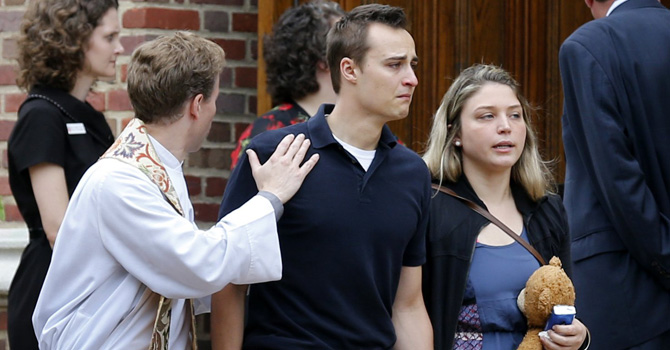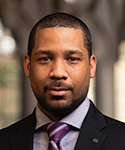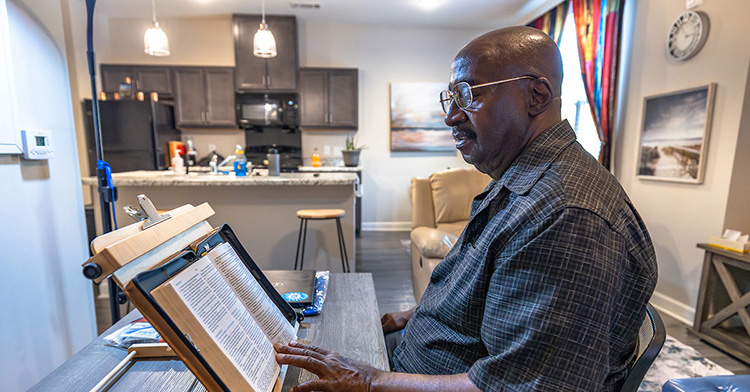I woke in a breathless panic. “A bad dream,” I told my wife, Abby, as we lay in the dark. “I was lost at sea, all alone, treading water, wave after wave pouring over me. The storm went on forever.”
“I’m no Sigmund Freud,” Abby said, “but given what you’ve been through, are you surprised?”
I serve as university chaplain at the University of Richmond, a broadly secular institution of 3,000 undergraduates and 1,000 graduate and professional students, and the previous five days had been the most difficult of my professional life.
After a dinner celebrating the end of the academic year with colleagues, I had slipped into bed a little early on Friday, May 9, 2014. It was the eve of commencement weekend, the most exhilarating and exhausting two days of the year.
My cellphone buzzed about 30 minutes later. A hot-air balloon had crashed earlier that evening in the countryside north of campus. Three people were aboard. Two of them, Ginny Doyle and Natalie Lewis, were members of our women’s basketball staff, both alumnae and former standout athletes who were known and loved in our community.
I went straight to our basketball arena and gathered with students, coaches, administrators and family members. We kept a gentle watch on one another through a long and anxious night.
Early the next morning, we received word that no one had survived. Our campus police chief tenderly made the announcement. I’ll never forget the sobs that tore through the room.
The following five days brought tidal waves of grief, an outpouring of support from across the country and profound questions: What happened? Why?
As God had brought peace to the chaotic waters at the beginning of time, and as Jesus had comforted his frightened disciples when the storm clouds rolled, so too would an enduring calm be found in this story of chaos and loss.
During the same time, my colleagues and I desperately tried to strike the right balance throughout commencement weekend. We tried to acknowledge both public grief and faithful joy, honoring the graduates and their accomplishments while recognizing the horror that had taken place.
All the while, we had to make significant strategic decisions, develop response plans, manage the crush of media attention and offer widespread pastoral care. A hastily organized remembrance service in our chapel drew more than 1,000 people, and scenes from the service played across the country on CNN and other national news outlets.
Sadly, this tragedy was not the first we had experienced. In addition to these two young women, 11 of our students or very recent graduates have died in the past three years, a tsunami of grief for our small campus.
As university chaplain, I aim to fulfill two responsibilities following each death. My institutional role is to guide the university’s collective response to the tragedy; my ordained call is to walk alongside those at the center of the story, shepherding family members, friends and colleagues along a journey for which no map exists.
At Richmond, we strive to be a community of intimacy and excellence. The intimacy creates scales of interaction that animate excellence, because community members get to know one another well and desire the good for each other.
Thus, I’ve learned that the ways in which institutions honor their dead and mourn with the grieving reflect the core virtues that shape the community’s ongoing life and sense of purpose.
As an institution, we have a policy that helps organize our response in times of tragedy. It offers enough stability to help guide a course of action. But because every person is unique and sacred, every death is also unique and sacred. Thus, the policy is designed to flex with the particular circumstances of each death.
As soon as possible, I convene a team of administrators and faculty who either know the student or are in a position to offer support to those who do. The key is to trust one another and the wisdom in the room to cultivate a response that is helpful and extends over time.
Part of the response is logistical and may have legal ramifications: ensure that the student’s parents do not receive a tuition bill or solicitation, secure the student’s email and on-campus accounts, take care of any possessions, including a car if the student has one, and so forth.
We also outline a communications strategy: Who will talk to the media? What will and can be said, and when?
By far, the most important work is pastoral. As a team, we seek to discern and reach out where the grief may be most acute. Who were the student’s roommates and closest friends? What were the campus activities she was involved with? Who were her teachers past and present? Who will reach out to each person? Who from the university is able to attend the hometown memorial service?
The deceased was a beloved son or daughter long before becoming a part of our community, so clear, consistent and ongoing communication with the family is critical. I establish a relationship with the family immediately, assuring them of the university’s love for their child and offering to serve as a facilitator for the chaotic array of local details that need to be handled, often from a distance, and always in the midst of overwhelming heartbreak.
Attentive pastoral care establishes trust and says to the family, “You do not walk alone,” thus creating space for the family to remember and mourn, relieved in part of the need to focus on logistics. In response to the gestures of support from many campus constituents, parents will often say, “I now understand why my child loved this place so much.”
Acute grief can feel like being lost at sea with little hope. Pastors and others attempting to guide individuals and institutions through tragic waters may also feel overwhelmed by helplessness. The breathless dream that flung me awake last May was a reflection of my own sadness, and the intense experience of being engulfed by waves of tears over the course of five days.
Two beacons helped order my steps. The first was a centered, though never sentimental, belief that as God had brought peace to the chaotic waters at the beginning of time, and as Jesus had comforted his frightened disciples when the storm clouds rolled, so too would an enduring calm be found in this story of chaos and loss. The second was a network of trusted colleagues and friends who rallied around me with courage and kindness, displaying the best of what our community aspires to be.
Tragedies will happen, and clergy and other institutional leaders will have to react. By planning ahead, and by trusting the wisdom and relationships already present in the community, leaders can respond with clarity and compassion, tenderly walking alongside the fragile suffering and offering shelter from the storm.
Questions to consider
Responding to tragedy
At the University of Richmond, the leadership team is governed by one key principle and three guiding questions.
Key principle:
Let the family lead.
Guiding questions:
Who needs to know?
When do they need to know?
What do they need to know?









